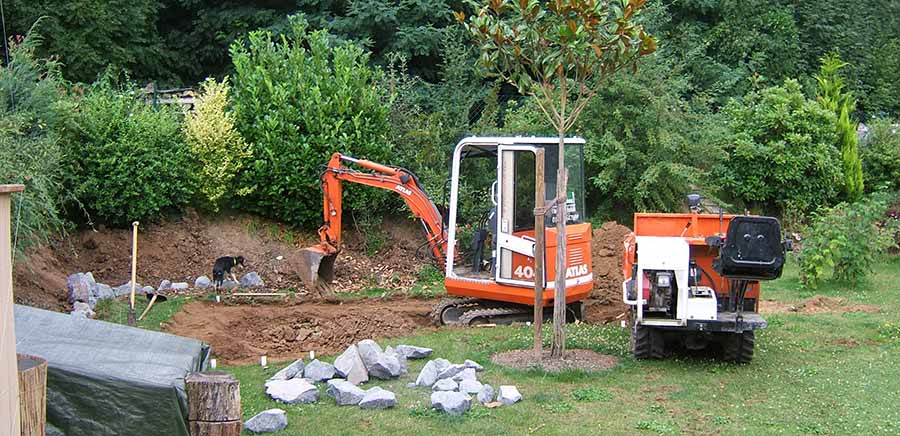An excavator is essential on a job site if you must dig through the ground, lift heavy soil or debris, and level the land. However, you need to use it properly, especially on slopes, to avoid getting injured or damaging the excavator, which is expensive to repair or replace.
You can operate an excavator safely on a slope by taking extra care and easing up on the speed, swing, and amount of soil you lift. Also, you should follow the operator manual guidelines to the letter concerning ratios.
The rest of the article will discuss in detail how you can safely use an excavator on a slope, the height of a slope that mini excavators can climb and whether or not you can operate a mini excavator on an incline. I will also explain the differences between excavators.
How to Excavate Safely on a Slope
If you need to operate an excavator on a slope, below are some essential safety tips to follow:
Choose the Right Excavator
Some excavators are not fit to operate on a slope, such as wheeled ones, which are designed to operate on even surfaces.
The best earthmover to use is a mini excavator with steel tracks and single-bar grousers. Its compact body and tracks enable it to grip the ground better for steady navigation. This helps you to reduce the risk of tipping over if you follow all the other safety measures.

Check the Excavator
Before you start excavating on a slope, ensure that the digger’s controls, access panels, components, and tracks are in good working condition. You do not want to be in a situation where you need to use certain gears but cannot because they are dead.
Furthermore, you should ensure that the excavator has enough oil since the vehicle will easily use it up as it moves uphill.
Evaluate the Slope
Knowing what ground conditions you are dealing with can help you determine how much grip you need to keep the excavator stable as you drive it. The surface of a slope can have a significant bearing on the machine’s stability.
Having this knowledge enables you to determine how much power you need to dig into the ground as a wet surface requires less effort to excavate than a dry and rocky one.
Drive Vertically
While traversing a slope, you should drive vertically with the bucket and boom extended in front of the machine for more stability as they provide a counterbalance. These will also help you to grab the surface if the excavator slips and prevent it from overturning.
Steering slowly as you make turns on a slope can also help you maintain control of the digger.
Swing at a Slow Pace
Lifting the material at a low speed will prevent the excavator from gaining unwanted momentum that can topple it. It’s also important to keep the bucket close to the ground and the machine as you swing to control the momentum.
Stay Focused
As you drive up and down a slope, you should pay careful attention to how you coordinate the controls while running the motors with your feet. Doing so will help you to keep the digger stable and avoid colliding with trees and rocks or falling into a ditch.
When you pull on roots and stones, they can give way, which can potentially destabilize the excavator.
Follow the Operator Manual Ratios
Operator manuals come with safe operating ratios for using an excavator on a slope. You should follow these guidelines diligently because as much as you can get away with pushing the limits, you will have a higher risk of sliding or rolling over the hill if you bump into a big rock or stump.
How Steep Can a Mini Excavator Climb?
A mini excavator can climb a maximum steep of 60% (or 30 degrees) depending on how powerful the engine is. The excavator manufacturer will specify the slope limit the earthmover can safely navigate without getting starved of oil for lubrication, and you should follow this instruction to avoid an accident.
Can You Use a Mini Excavator on a Slope?
You can use a mini excavator on a slope, but the height should be one that the earthmover can handle. Operating a compact digger on a hill beyond its limits can put you and the truck at risk of getting into an accident.
Smaller excavators are, however, easier to use on a slope than larger ones because they provide more stability. You can lower the dozer blade below you to stabilize the footing and reduce the possibility of sliding or tipping off the slope.
Are There Differences Between Excavators?
There are several differences between excavators as they come in various sizes. They also vary according to what type of terrain they can be used on, and how effectively they can dig up certain soil and dirt types.
To further understand the distinction between excavators, here’s a breakdown of all the types on the market:
Mini Excavators
These are the smallest excavators and are currently preferred by most contractors because they are more stable on the surface, limit ground damage, and can fit through small spaces.
Also, with a reduced or zero tail-swing, these compact excavators can move across tight spaces without bumping into objects.
Crawler Excavators
A crawler is a large excavator that runs slowly on two big tracks and is perfect for grading uneven terrain because it has better balance and stability than other excavators. Also, you can use it to lift heavy material, especially during heavy-duty construction and mining.
Wheeled Excavators
These are similar to crawlers, but instead of having tracks, they have wheelers that allow them to move fast and efficiently on flat surfaces, such as asphalt and concrete. They are widely used in urban places for road work because they are ill-suited to operate on uneven surfaces.
Long Reach Excavators
Long reach excavators have an extendable arm that enables them to operate in hard-to-reach and risky locations. For example, you can use them to demolish old and crumbling buildings, as well as constructions over water.
Suction Excavators
When you want to perform delicate underground excavating and reduce the risk of the ground collapsing, the suction excavator is the right digger to use.
It has a suction pipe that quickly sucks in soil or debris after the excavator has powered water on it to loosen it up.
Dragline Excavators
These diggers have a unique operation system whereby one side of the bucket is attached to a hoist rope and the other to a dragline that runs from the cab. As the rope lifts and lowers the bucket, the dragline pulls it toward the driver. This excavator is suitable for underwater projects.
Skid Steer Excavators
With their buckets and booms designed to face the opposite way from the driver, you can use skid steer excavators in narrow areas where you have to make tricky turns as they enable the attachments to pass above the cab instead of around it.
For this reason, they are commonly used to:
- Dig pools
- Remove debris
- Clean sites with limited space
Final Thoughts
The excavator you choose and how you operate it on a slope can determine your safety. If you keep the above-mentioned tips in mind when operating an excavator on a slope, you decrease your chances of an accident and ensure the longevity of your digger.

